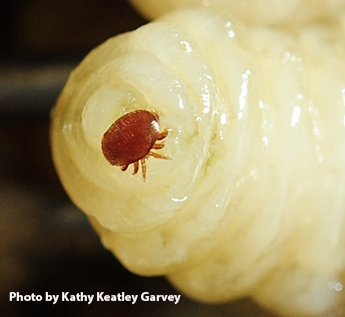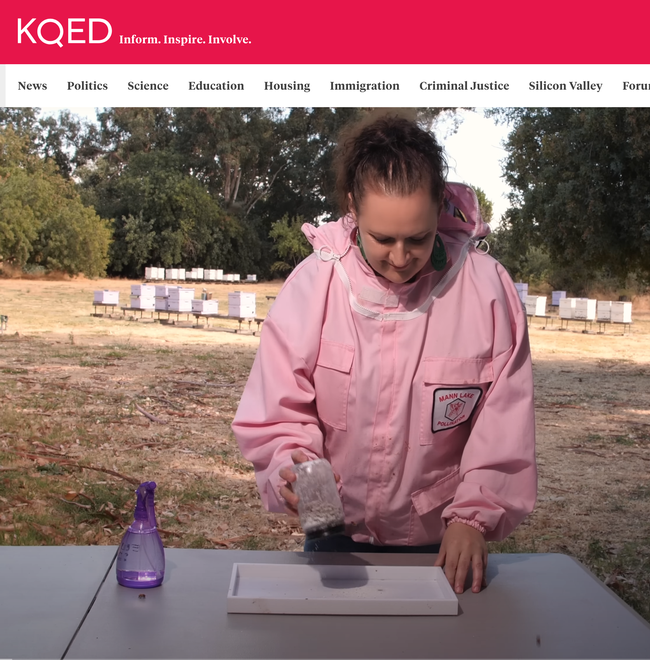- Author: Kathy Keatley Garvey

The Deep Look crew filmed the footage of the varroa mites with the assistance of Niño and Joseph Tauzer, manager of the Harry H. Laidlaw Jr. Honey Bee Research Facility, Bee Biology Road. Other segments of the production were filmed elsewhere.
The video was publicly released Oct. 24.
"They really did a great job, just like with the one on bee bread also done in my lab a few years back (2019)," said Niño, who also is the founder and director of the California Master Beekeeper Program. (See "Honey Bees Make Honey...and Bread?")
Varroa mites (Varroa destructor), natives of Asia, are external parasitic mites that feed on and weaken honey bees. They can spread such viruses as the deformed wing virus.
Beekeepers typically describe varroa mites as "Public Enemy No. 1" or as "A Beekeeper's Worst Enemy." In the Deep Look video, host Laura Klivans comments: "Every year, up to half the managed honeybee hives in the United States die from hazards like pesticide exposure, lack of flowers to forage on year-round, and varroa mites...varroa mites are great at sneaking into hives, hiding, and reproducing like mad."
Varroa mites reproduce only in a bee colony. The mites are small--measuring about 1–1.8 mm long and 1.5–2 mm wide--but they are huge to a bee. "It's as if you were carrying around a tick the size of a dinner plate," Klivans says.
Scientists first detected varroa mites in the United States in the 1980s. "They evolved on eastern honeybees, in Asia," Klivans notes. "That's why the western honeybees in the Americas and Europe aren't yet good at defending against them."
Research is underway to breed bees that will better target the mites. "The U.S. Department of Agriculture and private companies are breeding bees that can sniff out varroa mites," according to Deep Look. "When the bees find some, they uncap the cells and interrupt reproduction."
The video also focuses on "the sugar shake," a procedure used to monitor and estimate the number of varroa mites in a bee colony. It involves adding a half of a cup of bees (about 300) from the brood comb to a jar with a mesh lid, dropping in two tablespoons of confectioners' sugar, shaking the jar for 30 seconds to dislodge the mites, and emptying the contents on a tray. The beekeepers then count the number of varroa mites, estimate the severity of infestation, and decide what needs to be done.
Deep Look humorously describes the sugar-coated mites as "frosted varroa mites."
"The U.S. Department of Agriculture and private companies are breeding bees that can sniff out varroa mites," Klivans tells viewers. "When the bees find some, they uncap the cells and interrupt reproduction." Through queen bee insemination, scientists at Purdue and Central State universities are breeding honeybees known as “mite-biters." (See news story)
In addition to Niño and Tauzer, researchers consulted included Adam Finkelstein, VP Queen Bees; Krispn Given, Purdue Universities; Cameron Jack, University of Florida; Jeff Harris, Mississippi State University; Hongmei Li-Byarlay, Central State University; Samuel Ramsey, University of Colorado, Boulder; and Frank Rinkevich, USDA.
Credits include Deep Look producer/writer Gabriela Quirós; cinematographer Josh Cassidy; narrator/writer Laura Klivans; original music Seth Samuel; and editors/motion graphics Gabriela Quirós and Kia Simon.
In 2007, Deep Look filmed bee breeder-geneticist Susan Cobey (now of Washington State University) inseminating bee queens in the Laidlaw lab. At the time, Cobey managed the Laidlaw facility. Also in the video, the late Eric Mussen (1944-2022), Extension apiculturist and member of the UC Davis Department of Entomology and Nematology faculty, discusses colony collapse disorder.



